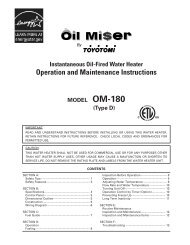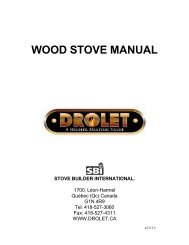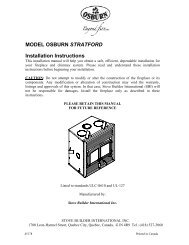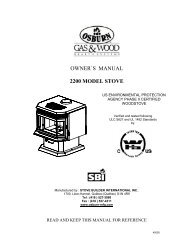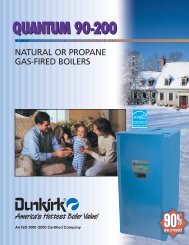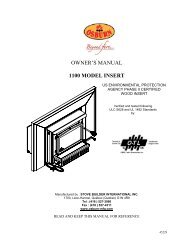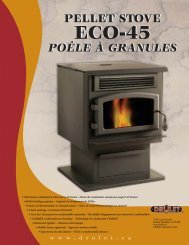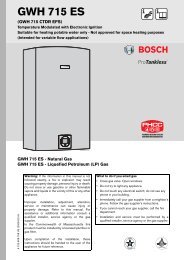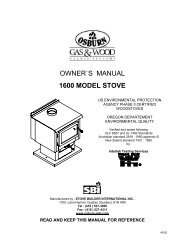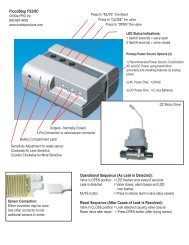Owner's Manual Osburn 2000 Wood Stove Insert - Rural Energy ...
Owner's Manual Osburn 2000 Wood Stove Insert - Rural Energy ...
Owner's Manual Osburn 2000 Wood Stove Insert - Rural Energy ...
Create successful ePaper yourself
Turn your PDF publications into a flip-book with our unique Google optimized e-Paper software.
6. OPENING SIZE: Refer to “Suitable Fireplace Dimensions” (Sec. 2.2) for suitable size<br />
fireplace<br />
openings.<br />
NOTE: A METAL TAG IS PROVIDED AND IS TO BE FASTENED TO THE BACK<br />
WALL OF THE FIREPLACE IF THE FIREPLACE HAS BEEN MODIFIED TO<br />
ACCOMMODATE THE INSERT.<br />
2.2. VENTING REQUIREMENTS<br />
The flue is a critical component to a satisfactory installation. Your insert will attain its best<br />
performance if installed with a flue that generates its own draft. The minimum venting requirement<br />
will be the installation of a flue connector from the insert into the first tile of the chimney (see<br />
Figure 3.3). If you are using a masonry chimney, it is important that it be built in compliance with<br />
the specifications of the National Building Code or other applicable standard having jurisdiction. It<br />
must be lined with fire clay bricks, metal or clay tiles sealed together with fire cement (round flues<br />
are the most efficient). Ideally, the interior diameter of the masonry chimney should be identical to<br />
the insert smoke exhaust. You may also run a stainless steel liner inside the masonry chimney. A<br />
continuous 6" (152mm) stainless steel liner from the top of the chimney to the insert’s smoke<br />
exhaust (see Figure 3.2) is the optimum system and will provide the best performance, as well as<br />
compensate for poor draft situations caused by large cross-sectional chimneys. The insert will not<br />
work without a positive seal in the chimney.<br />
Chimneys constructed outside of the home, on an exterior wall, should be avoided if possible,<br />
especially in colder climates. Outside chimneys may not draw as well and may downdraft due to<br />
the difficulty in heating them up to operating temperature. Cooler chimneys will result in increased<br />
creosoting, less draft, and poorer performance. Draft is proportional to overall chimney height as<br />
well as to stack temperature. Draft can be increased by increasing chimney height, and by<br />
reducing heat loss from the chimney through an insulated liner.<br />
Ensure that all joints in the flue systems are tightly sealed, since any leaks will result in reduced<br />
performance as well as a possible safety hazard. Using a fire screen at the extremity of the<br />
chimney requires regular inspection in order to insure that it is not obstructed thus blocking the<br />
draught, and it should be cleaned when necessary.<br />
Do not connect this unit to a chimney flue serving another appliance.<br />
This heating unit must serve as a supplementary heat source. An alternate heat source should be<br />
available in the home if needed. The manufacturer cannot be responsible for additional heating<br />
costs associated with the use of an alternative heat source.<br />
It is recommended that the user buys this product from a retailer who can provide installation and<br />
maintenance advices.<br />
5



